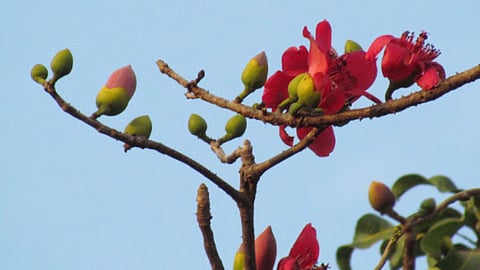

BY ASAVARI KULKARNI
Spring is here, and what better harbinger of it than the sawar tree in Goa, which gives one an indication of a hot or normal summer and tells us of early or late arrival of monsoon.
The festival of Vasant Panchami, also known as Basant Panchami, and Rath Saptami, marks the onset of the spring season. The change in the season can be very well noticed in the forests of Goa.
At this time of the year, different species of trees with vibrant colours and scents start blooming. Butea monosperma (palash), memecylon umbellatum (ironwood tree), mimusops elengi (ovla), pandanus (kevada, hato) and erythrina indica (pangaro) are among the trees that start blooming all over Goa at this time of the year.
One of the important tree species which adds to these vibrant colours is the sawar (also savari) or silk cotton tree. Botanically, it is known as bombax ceiba, and in Konkani it is known as sawar, shalmali in Sanskrit and semal in Hindi. This is one of the deciduous trees that shed all leaves by November and soon after that small green buds start appearing.
SIGNS OF WARM SUMMER
In January, silky, red and fluffy flowers begin to bloom which makes the tree stand out in the forest. This year, the flowers of the sawar tree are blooming in mid-February, which means Goa will witness a very warm summer and likely late monsoon -- an indication of global climate warming.
The flowers of sawar tree contain abundant nectar, making it a favourite for birds. The flowers with numerous pollen and anthers get cross-pollinated by the avian visitors as a result of which the fruit yield is healthy.
The fruit in the form of pods appears in March-April depending upon the period of flowering. The cotton fibres of this tree burst and can be seen floating in the wind around the time of early May. Traditionally, the bursting of the pods of this tree was an indication of the approaching monsoon.
SACRED AND MEDICINAL
The tree finds its way into people's lives in the form of medicines or home remedies. This tree is also considered sacred by some people as it is believed that Bramha after creating the earth was exhausted and rested under the shade of this tree.
According to a story from the Mahabharata, Draupadi, the wife of the five Pandavas, cursed this tree due to which it bears thorns when fully grown.
In Goa, too, sawar tree is considered sacred. It is interesting to know that many places find their etymological roots in forest trees. For instance, names of places such as Savaridhat, Savaribhat and Savarde originate from sawar.
Then there are bus stops which are known as savari kade (near sawar), which means there is a presence of the tree near the stop.
The tree is one of the primary colonisers in deciduous forests and plateaus. It can be grown from seeds and grows at a faster rate, hence is a good species for the restoration of degraded lands such as in mining areas.
ABUNDANCE IN GOA
The wood of sawar is soft and hence is considered to be of low value, but it has great medicinal value and finds its place in Ayurveda and also in folk medicine. Almost every part of the tree is considered medicinal. Roots and flowers are most commonly used to treat ailments.
The gum derived from this tree is used to treat dental pain in some parts of Goa. Its flowers are used for the treatment of diabetes. The dried buds from this tree are used as a spice in some parts of south India.
The cotton derived from this tree is used for filling low-priced pillows and quilts commonly used in rural areas of Goa.
The State is abundantly blessed with this valuable tree. However, ignorance, increasing construction activities and mining have posed threat to its existence. The tree is economically important and at the same time plays a beneficial ecological role in nature.
One can find this tree in some of the unlikeliest places making the area where it stands a sight to behold. So, the next time you see an area covered in bright red, look up and you will realise happiness comes from small things in life!